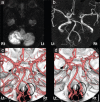Clinical Characteristics of Cerebellar Infarction Due to Arterial Dissection
- PMID: 30459855
- PMCID: PMC6208259
- DOI: 10.4103/ajns.AJNS_373_16
Clinical Characteristics of Cerebellar Infarction Due to Arterial Dissection
Abstract
Objectives and background: Arterial dissection (AD) of the vertebral artery (VA) or its branches may cause ischemic stroke of the posterior circulation. However, clinical and radiological characteristics of patients with AD-related cerebellar infarction (CI) have rarely been reported.
Methods: Forty-nine patients with CI admitted to our department from April 2008 to March 2015 were identified from our database. After dichotomization into the AD and non-AD group, their demographics and presenting symptoms were compared. Subsequently, a multivariate regression analysis was performed to identify variables that correlated with AD.
Results: During the 7-year period, 14 and 35 patients were identified in the AD and non-AD group, respectively. The AD group was significantly younger than the non-AD group (55.0 ± 16.3 vs. 69.7 ± 10.7 years, P = 0.001) and was also more likely to experience acute pain at onset (86% vs. 17%, P < 0.001). Using a multivariate regression analysis, these two variables and the male sex were found to correlate with AD. AD was located in extracranial VA (n = 3); intracranial VA (n = 8); posterior inferior cerebellar artery (PICA) (n = 3); and superior cerebellar artery (n = 1). Identification of AD was delayed in one patient with an extracranial VA and one patient with a PICA dissection.
Conclusions: AD was responsible for approximately 30% of CI in our cohort. Pain at onset may be a useful symptom to identify patients with AD-related CI. While intracranial VA was the most common location of AD, physicians should be aware of the possibility of extracranial VA or PICA dissection in patients with seemingly unremarkable radiological findings.
Keywords: Arterial dissection; cerebellar infarction; extracranial; posterior inferior cerebellar artery; vertebral artery.
Conflict of interest statement
There are no conflicts of interest.
Figures


References
-
- Edlow JA, Newman-Toker DE, Savitz SI. Diagnosis and initial management of cerebellar infarction. Lancet Neurol. 2008;7:951–64. - PubMed
-
- Debette S, Compter A, Labeyrie MA, Uyttenboogaart M, Metso TM, Majersik JJ, et al. Epidemiology, pathophysiology, diagnosis, and management of intracranial artery dissection. Lancet Neurol. 2015;14:640–54. - PubMed
-
- Kobayashi H, Morishita T, Ogata T, Matsumoto J, Okawa M, Higashi T, et al. Extracranial and intracranial vertebral artery dissections: A comparison of clinical findings. J Neurol Sci. 2016;362:244–50. - PubMed
-
- Ramphul N, Geary U. Caveats in the management and diagnosis of cerebellar infarct and vertebral artery dissection. Emerg Med J. 2009;26:303–4. - PubMed
-
- Masuda Y, Tei H, Shimizu S, Uchiyama S. Factors associated with the misdiagnosis of cerebellar infarction. J Stroke Cerebrovasc Dis. 2013;22:1125–30. - PubMed
LinkOut - more resources
Full Text Sources
Miscellaneous

